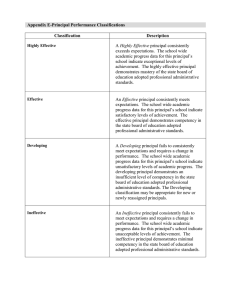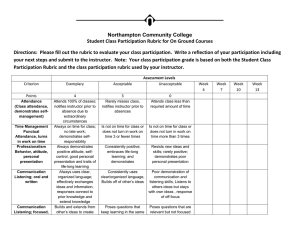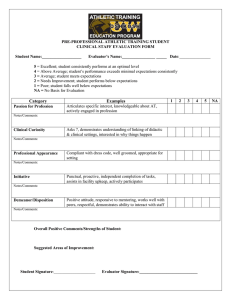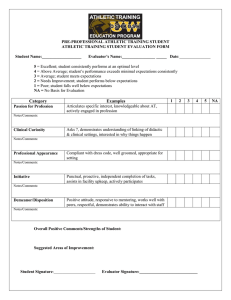Reading/Language Arts
advertisement
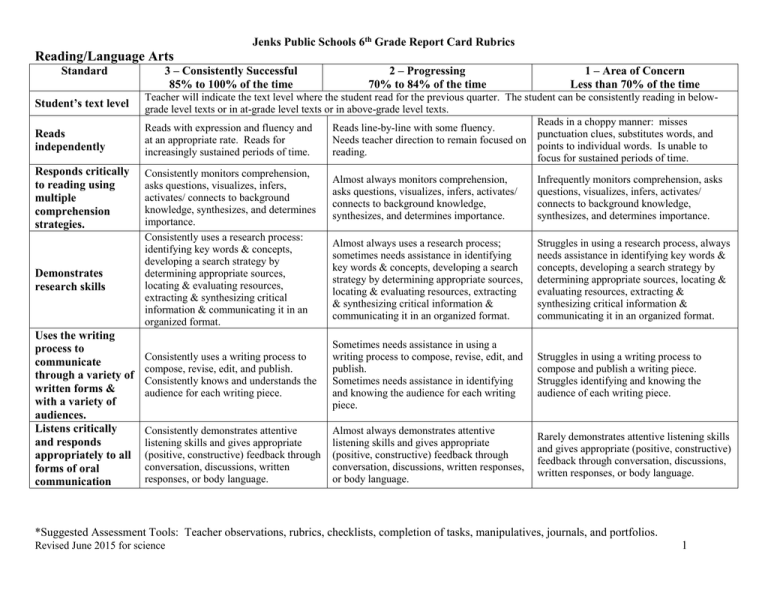
Jenks Public Schools 6th Grade Report Card Rubrics Reading/Language Arts Standard Student’s text level Reads independently Responds critically to reading using multiple comprehension strategies. Demonstrates research skills Uses the writing process to communicate through a variety of written forms & with a variety of audiences. Listens critically and responds appropriately to all forms of oral communication 3 – Consistently Successful 85% to 100% of the time 2 – Progressing 70% to 84% of the time 1 – Area of Concern Less than 70% of the time Teacher will indicate the text level where the student read for the previous quarter. The student can be consistently reading in belowgrade level texts or in at-grade level texts or in above-grade level texts. Reads in a choppy manner: misses Reads with expression and fluency and Reads line-by-line with some fluency. punctuation clues, substitutes words, and at an appropriate rate. Reads for Needs teacher direction to remain focused on points to individual words. Is unable to increasingly sustained periods of time. reading. focus for sustained periods of time. Consistently monitors comprehension, Almost always monitors comprehension, Infrequently monitors comprehension, asks asks questions, visualizes, infers, asks questions, visualizes, infers, activates/ questions, visualizes, infers, activates/ activates/ connects to background connects to background knowledge, connects to background knowledge, knowledge, synthesizes, and determines synthesizes, and determines importance. synthesizes, and determines importance. importance. Consistently uses a research process: Almost always uses a research process; Struggles in using a research process, always identifying key words & concepts, sometimes needs assistance in identifying needs assistance in identifying key words & developing a search strategy by key words & concepts, developing a search concepts, developing a search strategy by determining appropriate sources, strategy by determining appropriate sources, determining appropriate sources, locating & locating & evaluating resources, locating & evaluating resources, extracting evaluating resources, extracting & extracting & synthesizing critical & synthesizing critical information & synthesizing critical information & information & communicating it in an communicating it in an organized format. communicating it in an organized format. organized format. Consistently uses a writing process to compose, revise, edit, and publish. Consistently knows and understands the audience for each writing piece. Sometimes needs assistance in using a writing process to compose, revise, edit, and publish. Sometimes needs assistance in identifying and knowing the audience for each writing piece. Struggles in using a writing process to compose and publish a writing piece. Struggles identifying and knowing the audience of each writing piece. Consistently demonstrates attentive listening skills and gives appropriate (positive, constructive) feedback through conversation, discussions, written responses, or body language. Almost always demonstrates attentive listening skills and gives appropriate (positive, constructive) feedback through conversation, discussions, written responses, or body language. Rarely demonstrates attentive listening skills and gives appropriate (positive, constructive) feedback through conversation, discussions, written responses, or body language. *Suggested Assessment Tools: Teacher observations, rubrics, checklists, completion of tasks, manipulatives, journals, and portfolios. Revised June 2015 for science 1 Jenks Public Schools 6th Grade Report Card Rubrics Mathematics: EDM Standard 3 – Consistently Successful 85% to 100% of the time 2 – Progressing 70% to 84% of the time 1 – Area of Concern Less than 70% of the time Demonstrates understanding in number systems. Consistently demonstrates competence in problem solving and using the mathematical practices to develop and explain solutions. Consistently applies number sense and operations to rational numbers, investigating number systems, and using rules of exponents. Demonstrates understanding in ratios/proportions. Consistently demonstrates understanding in problem solving with ratios/ proportional relationships. Sometimes needs assistance in demonstrating understanding in problem solving with ratios/ proportional relationships. Rarely demonstrates understanding in problem solving with ratios/proportional relationships, without assistance. Demonstrates understanding in expressions and equations. Consistently identifies and solves for variables in expressions and equivalent equations Sometimes needs assistance in identifying and solving for variables in expressions and equivalent equations Rarely identifies and solves for variables in expressions and equivalent equations without assistance. Develops understanding in statistics and probability. Consistently collects, organizes, constructs, and interprets displays of data and understands probability concepts. Sometimes needs assistance in collecting, organizing, constructing and interpreting displays of data and understanding probability concepts. Rarely collects, organizes, constructs, and interprets displays of data for graphs or understands probability concepts. Demonstrates skill in problem solving Sometimes needs assistance with problem solving using the mathematical practices to develop and explain solutions. Rarely demonstrates competence in problem solving; struggles with the mathematical practices. Sometimes needs assistance in applying number sense and operations to rational numbers, investigating number systems, and using rules of exponents. Rarely applies number sense and operations to rational numbers, investigating number systems, and using rules of exponents. *Suggested Assessment Tools: Teacher observations, rubrics, checklists, completion of tasks, manipulatives, journals, and portfolios. Revised June 2015 for science 2 Jenks Public Schools 6th Grade Report Card Rubrics Mathematics: Pre-Algebra Standard Demonstrates skill in problem solving Demonstrates understanding in number systems. 3 – Consistently Successful 85% to 100% of the time Consistently demonstrates competence in problem solving and using the mathematical practices to develop and explain solutions. Consistently applies number sense and operations to rational numbers, investigating number systems, and using rules of exponents. 2 – Progressing 70% to 84% of the time 1 – Area of Concern Less than 70% of the time Sometimes needs assistance with problem solving using the mathematical practices to develop and explain solutions. Rarely demonstrates competence in problem solving; struggles with the mathematical practices. Sometimes needs assistance in applying number sense and operations to rational numbers, investigating number systems, and using rules of exponents. Rarely applies number sense and operations to rational numbers, investigating number systems, and using rules of exponents. Rarely identifies and solves for variables in expressions and equivalent equations without assistance. Rarely applies properties of geometric shapes and spatial relationships; usually needs assistance. Rarely demonstrates understanding in problem solving with ratios/proportional relationships, without assistance. Rarely collects, organizes, constructs, and interprets displays of data for graphs or understands probability concepts. Demonstrates understanding in expressions and equations. Consistently identifies and solves for variables in expressions and equivalent equations Sometimes needs assistance in identifying and solving for variables in expressions and equivalent equations Demonstrates understanding in geometric measurement Consistently applies properties of geometric shapes and spatial relationships. Sometimes needs assistance applying properties of geometric shapes and spatial relationships. Demonstrates understanding in ratios/ proportional relationships Consistently demonstrates understanding in problem solving with ratios/ proportional relationships. Sometimes needs assistance in demonstrating understanding in problem solving with ratios/ proportional relationships. Develops understanding in statistics and probability Consistently collects, organizes, constructs, and interprets displays of data and understands probability concepts. Sometimes needs assistance in collecting, organizing, constructing and interpreting displays of data and understanding probability concepts. *Suggested Assessment Tools: Teacher observations, rubrics, checklists, completion of tasks, manipulatives, journals, and portfolios. Revised June 2015 for science 3 Jenks Public Schools 6th Grade Report Card Rubrics Mathematics: Algebra Standard Demonstrates skill in problem solving. Demonstrates understanding in the real number system. Demonstrates understanding in expressions, equations, and inequalities. Demonstrates understanding in interpreting functions Demonstrates understanding with polynomial/ rational expressions. 3 – Consistently Successful 85% to 100% of the time Consistently demonstrates competence in problem solving and using the mathematical practices to develop and explain solutions. Consistently applies number sense and operations to investigating number systems, using rules of exponents, and translating mathematical symbols and verbal expressions. 2 – Progressing 70% to 84% of the time 1 – Area of Concern Less than 70% of the time Sometimes needs assistance with problem solving using the mathematical practices to develop and explain solutions. Rarely demonstrates competence in problem solving; struggles with the mathematical practices. Sometimes needs assistance in applying number sense and operations to investigating number systems, using rules of exponents, and translating mathematical symbols and verbal expressions. Sometimes needs assistance in identifying and solving for variables in inequalities and equivalent equations Rarely applies number sense and operations to investigating number systems, using rules of exponents, and translating mathematical symbols and verbal expressions. Rarely identifies and solves for variables in inequalities and equivalent equations without assistance. Consistently demonstrates understanding in problem solving with functions. Sometimes needs assistance in understanding problem solving with functions. Rarely understands functions without assistance. Consistently demonstrates understanding in working with polynomial/ rational expressions concepts. Sometimes needs assistance in demonstrating understanding in working with polynomial/ rational expressions concepts. Rarely demonstrates understanding in working with polynomial/ rational expressions concepts, without assistance. Consistently identifies and solves for variables in inequalities and equivalent equations *Suggested Assessment Tools: Teacher observations, rubrics, checklists, completion of tasks, manipulatives, journals, and portfolios. Revised June 2015 for science 4 Jenks Public Schools 6th Grade Report Card Rubrics Science 3 – Consistently Successful 85% to 100% of the time Consistently uses science and Understands engineering design processes and tools and uses e.g., science and engineering Asking questions; defining problems practices Developing and using models Planning and carrying out investigations Analyzing and interpreting data Using mathematics and computational thinking Constructing explanations and designing solutions Engaging in argument from evidence Obtaining, evaluating, and communicating information Communicates Consistently uses understanding of understanding concepts and key ideas when of concepts and contributing to class discussions, participating in group and individual content investigations, and completing oral and written communication tasks. Standard 2 – Progressing 70% to 84% of the time In consistently uses science and engineering design processes and tools, sometimes needing assistance, e.g., Asking questions; defining problems Developing and using models Planning and carrying out investigations Analyzing and interpreting data Using mathematics and computational thinking Constructing explanations and designing solutions Engaging in argument from evidence Obtaining, evaluating, and communicating information. Area of Concern Less than 70% of the time Seldom, even with assistance, is able to use science and engineering design processes and tools e.g., Asking questions; defining problems Developing and using models Planning and carrying out investigations Analyzing and interpreting data Using mathematics and computational thinking Constructing explanations and designing solutions Engaging in argument from evidence Obtaining, evaluating, and communicating information Inconsistently uses understanding of Rarely, even with assistance, uses concepts and key ideas when contributing to understanding of concepts and key ideas class discussions, participating in group and when contributing to class discussions, individual investigations, and completing participating in group and individual oral and written communication tasks; investigations, and completing oral and sometimes needs assistance. written communication tasks. *Suggested Assessment Tools: Teacher observations, rubrics, checklists, completion of tasks, manipulatives, journals, and portfolios. Revised June 2015 for science 5 Jenks Public Schools 6th Grade Report Card Rubrics Social Studies Standard Displays understanding of geography and its impact 3 – Consistently Successful 85% to 100% of the time Consistently demonstrates knowledge of geography and makes connections between geography and its impact on people, cultures, and the environment. Locates and interprets Consistently demonstrates skill in using a variety of geographical tools information using a to locate and interpret information. geographical tools Shows understanding of concepts through speaking, listening, and writing Consistently participates in class discussions and contributes relevant information; uses writing to demonstrate understanding. 2 – Progressing 70% to 84% of the time 1 – Area of Concern Less than 70% of the time Sometimes demonstrates knowledge of geography and makes connections between geography and its impact on people, cultures, and the environment. Rarely demonstrates knowledge of geography and makes connections between geography and its impact on people, cultures, and the environment. Inconsistently demonstrates skill in using a variety of geographical tools to locate and interpret information; sometimes needs assistance. Sometimes participates in class discussions and contributes relevant information; sometimes uses writing to demonstrate understanding Rarely demonstrates skill in using a variety of geographical tools to locate and interpret information; requires assistance. Rarely participates in class discussions or contributes relevant information; rarely uses writing to demonstrate understanding Technology Standard Demonstrates keyboarding skills. Uses various technologies to find, evaluate, organize and present information. 3 – Consistently Successful 85% to 100% of the time 2 – Progressing 70% to 84% of the time Consistently uses appropriate posture, finger positions, and key stroking; demonstrates skill in keeping eyes on the screen; and typing a minimum of 30 words per minute with 95% accuracy in three 3-minute timed writings. Demonstrates skill in producing a web page with classmates, in using/developing a wiki (simplified website using wiki software), blog or pod cast with classmates, and in locating (using key words), navigating and evaluating the accuracy, relevance, and bias of Internet sites. Is inconsistent with posture, finger positions, and key stroking; developing skill in keeping eyes on the screen and typing a minimum of 30 words per minute with 95% accuracy in three 3-minute timed writings. Uses one or two fingers and searches the keyboard to find the correct key. Occasionally needs assistance in producing a web page with classmates, in using/developing a wiki (simplified website using wiki software), blog or pod cast with classmates, and in locating (using key words), navigating and evaluating the accuracy, relevance, and bias of Internet sites. Must have assistance in producing a web page with classmates, in using/developing a wiki (simplified website using wiki software), blog or pod cast with classmates, and in locating (using key words), navigating and evaluating the accuracy, relevance, and bias of Internet sites. Area of Concern Less than 70% of the time *Suggested Assessment Tools: Teacher observations, rubrics, checklists, completion of tasks, manipulatives, journals, and portfolios. Revised June 2015 for science 6 Jenks Public Schools 6th Grade Report Card Rubrics Spanish I and Chinese I Standard 3 – Consistently Successful 85% to 100% of the time 2 – Progressing 70% to 84% of the time Area of Concern Less than 70% of the time Comprehends communications on familiar topics and classroom procedures Uses formal and informal language to express needs and common courtesies and to ask and answer questions based on self and familiar topics Reads short, authentic texts Consistently listens, understands, and responds to communications on familiar topics and classroom procedures. Needs support with listening, understanding, and responding to communications on familiar topics and classroom procedures. Struggles with listening, understanding, and responding to communications on familiar topics and classroom procedures. Fluently uses formal and informal language to express needs and common courtesies and to ask and answer questions based on self and familiar topics. Needs support in using formal and informal language to express needs and common courtesies and to ask and answer questions based on self and familiar topics. Rarely uses the language to express needs and common courtesies or to ask and answer questions based on self and familiar topics. Reads fluently in short, authentic texts. Rarely reads short, authentic texts. Uses basic grammatical structures to write about familiar topics Communicates understanding of similarities and differences between the target culture and own Consistently uses basic grammatical structures to write about familiar topics. Can describe similarities and differences between the target culture and own. Needs support in reading short, authentic texts. Needs support in using basic grammatical structures to write about familiar topics. Can recognize differences; needs support in naming similarities between the target culture and own. Struggles to write in the target language. Struggles to recognize similarities and differences between the target culture and own. World Languages: Chinese & Spanish Standard 3 – Consistently Successful 85% to 100% of the time 2 – Progressing 70% to 84% of the time Area of Concern Less than 70% of the time Understands learned Consistently listens and understands Needs support with listening and Struggles with listening and statements, questions, learned statements, questions, understanding learned statements, understanding learned statements, commands, & greetings commands, and greetings. questions, commands, and greetings. questions, commands, and greetings. through listening techniques Uses formal and informal Is fluent in expressing needs and Needs support in expressing needs & Rarely uses the language to express language to express needs and common courtesies in the language. common courtesies in the language. needs and common courtesies. common courtesies Reads learned words and Consistently knows and understands Needs support with learned words and Rarely identifies learned words and learned words and phrases. phrases. phrases. phrases in simple texts *Suggested Assessment Tools: Teacher observations, rubrics, checklists, completion of tasks, manipulatives, journals, and portfolios. Revised June 2015 for science 7 Jenks Public Schools 6th Grade Report Card Rubrics Writes using familiar words and phrases reproduced from memory Communicates understanding of similarities and differences between the target culture and own Consistently write familiar words or phrases reproduced from memory. Needs support in reproducing from memory and writing familiar words or phrases. Struggles to write familiar words or phrases; cannot reproduce them from memory. Can describe similarities and differences between the target culture and own. Can recognize differences; needs support in naming similarities between the target culture and own. Struggles to recognize similarities and differences between the target culture and own. *Suggested Assessment Tools: Teacher observations, rubrics, checklists, completion of tasks, manipulatives, journals, and portfolios. Revised June 2015 for science 8
